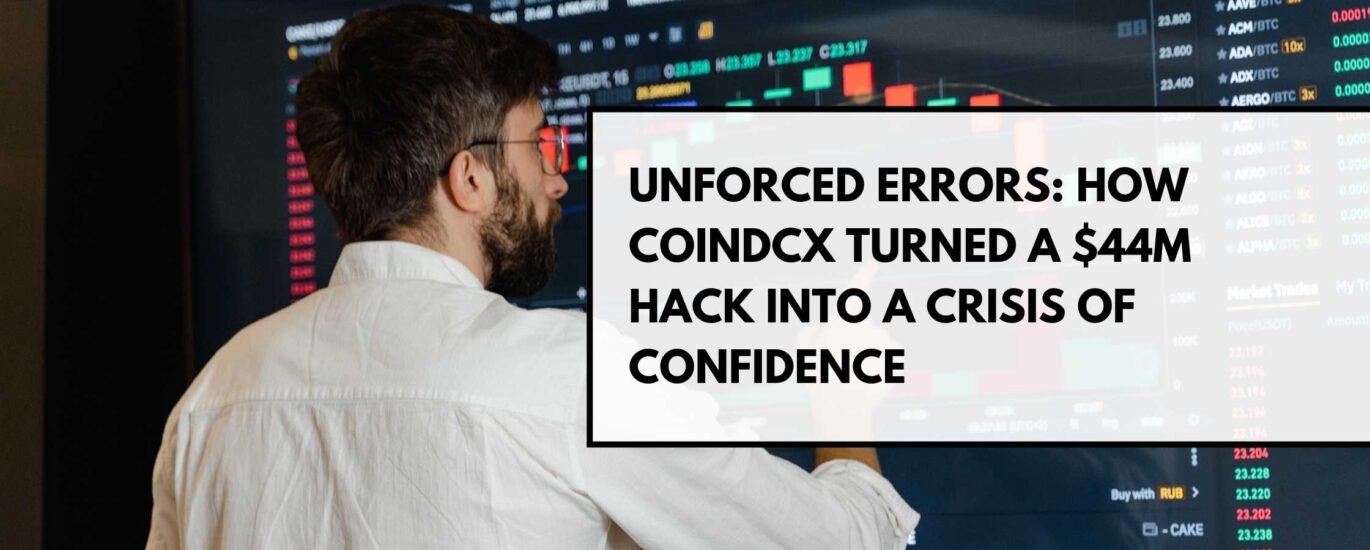Introduction: The Hack That Didn’t Have to Become a Meltdown
Crypto hacks are unfortunately common. But how an exchange responds — how fast, how clearly, how credibly — can mean the difference between a hiccup and a full-blown crisis.
On July 19, 2025, CoinDCX lost $44.2 million from an operational wallet. That’s serious — but survivable. What came next made it worse: a prolonged silence, a stream of vague reassurances, and no meaningful proof to back up any of their claims.
This wasn’t just a hack. It was an unforced error in communication, accountability, and transparency.
1. They Didn’t Break Their Own News
CoinDCX wasn’t the first to report the exploit. That dishonor went to Cyvers Alerts, a blockchain threat detection platform. Then ZachXBT, a respected independent investigator, traced the flows and confirmed it was CoinDCX’s wallet.
Only 17 hours after these public alerts did CoinDCX step in and confirm the breach.
Let that sink in:
In a 24/7 market where millions of dollars can move in seconds, CoinDCX left users in the dark for nearly an entire day.
“We were waiting to complete internal checks”
— CoinDCX
But waiting 17 hours isn’t caution — it’s negligence in the context of user trust and financial safety.
2. They Reassured Without Evidence
Once they did speak, CoinDCX rushed to calm nerves. They said:
- “User funds are safe.”
- “We’re absorbing the loss.”
- “Funds are segregated.”
- “We remain extremely profitable.”
But what did they show? Nothing concrete.
There was:
- No breakdown of the hack.
- No wallet list of affected addresses.
- No details on how the loss would be covered.
- No public-facing audit or proof of reserves.
These were words, not facts. Promises, not proof.
3. They Showed a Screenshot, Not a System
To “prove” they were solvent, CoinDCX linked to CoinGabbar, a third-party dashboard of wallet balances. But this dashboard:
- Wasn’t independently verified
- Didn’t include liabilities
- Didn’t let users verify their own balances
- Didn’t include legal segregation or custodial guarantees
In contrast, legitimate proof-of-reserves systems include:
- A Merkle Tree with user-verifiable hashes
- A liabilities report showing user obligations
- A third-party audit firm signing off on balances
- Legal structuring to protect customer funds in insolvency
CoinDCX’s approach amounted to saying:
“Look, there’s money in our wallet. Trust us.”
That might’ve worked in 2021. It doesn’t fly in 2025.
4. They Underestimated the Community’s Maturity
CoinDCX’s response might’ve been acceptable in the bull run days when people were chasing altcoins without reading terms of service. But post-FTX, post-Celsius, post-WazirX — the user base has matured.
Crypto users now ask:
- Are my funds legally protected?
- Is the platform insolvent if something goes wrong?
- Can I verify my account is covered in reserves?
- Will they be honest with me when things break?
CoinDCX didn’t meet those expectations. Instead, their YouTube stream was described by one viewer as:
“All vibes, no answers.”
5. They Ignored Lessons from WazirX
WazirX was hammered in 2024 when it was hacked for $234.9M. But it learned.
Here’s what WazirX did post-breach:
- Created a user-verifiable Merkle Tree of liabilities
- Filed court-approved restructuring plans in Singapore
- Pledged 85% fund recovery via legal mechanisms
- Engaged creditors in a transparent voting process
CoinDCX, by contrast:
- Refused to publish liabilities
- Did not involve any legal court process
- Offered no recovery timeline
- Called it a “small incident” and moved on
Yet somehow, CoinDCX has avoided the backlash. Why?
Because the damage wasn’t immediate and obvious. But that doesn’t mean it isn’t real.
6. They Failed to Address Legal Protection
Here’s the most under-discussed part: legal segregation of funds.
CoinDCX claims that “user funds are segregated.” But unless those funds are held under:
- A legal trust
- A custodial agreement
- A separate legal entity not subject to creditor claims
…then the claim is worthless.
We’ve seen this before:
- FTX: “Segregated” funds — turned out they weren’t.
- Celsius: Claimed user coins were safe — then declared them “property of the estate.”
- Voyager: Filed bankruptcy — users queued up with other creditors.
Until CoinDCX publishes the legal structure of its custody and fund management, users are not protected.
7. They Missed a Leadership Moment
CoinDCX had a chance to set the bar in India — to say:
- We believe in radical transparency.
- We’ll show you everything: our wallets, our liabilities, our legal setup.
- We’ll involve users in a recovery process, just like mature jurisdictions demand.
They could’ve led the Indian crypto industry into a new chapter of trust.
Instead, they smiled on camera, posted a few tweets, and moved on.
8. What CoinDCX Needs to Do Now
If CoinDCX wants to remain a serious player, it should immediately:
| Action Needed | Why It Matters |
| Publish liabilities | Prove it can back all user balances 1:1 |
| Share wallet structure | Allow public tracking of recovery efforts |
| Deliver a Merkle Tree | Let users verify their accounts are covered |
| Provide legal segregation | Protect users in the event of platform failure |
| Hire an external auditor | Validate solvency and risk management |
These aren’t overreactions. They’re the minimum required in today’s environment.
Conclusion: The Hack Was Bad — But the Response Was Worse
CoinDCX didn’t choose to be hacked. But it chose how to respond.
By:
- Delaying the disclosure
- Avoiding documentation
- Downplaying the risk
- Refusing legal and financial transparency
…CoinDCX damaged user trust far more than the $44M ever could.
In crypto, mistakes happen. What defines an exchange is how it handles them.
Until CoinDCX steps up with proof, not PR, users are right to be wary.






